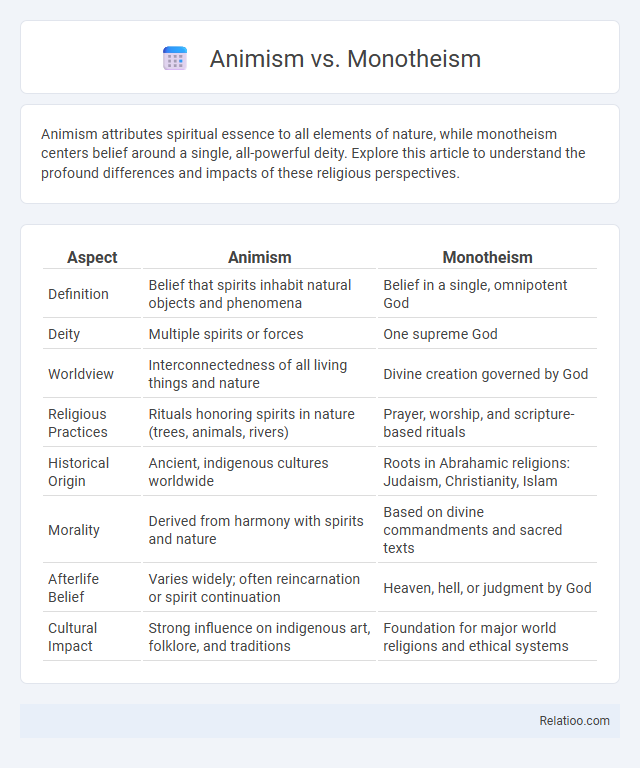Animism attributes spiritual essence to all elements of nature, while monotheism centers belief around a single, all-powerful deity. Explore this article to understand the profound differences and impacts of these religious perspectives.
Table of Comparison
| Aspect | Animism | Monotheism |
|---|---|---|
| Definition | Belief that spirits inhabit natural objects and phenomena | Belief in a single, omnipotent God |
| Deity | Multiple spirits or forces | One supreme God |
| Worldview | Interconnectedness of all living things and nature | Divine creation governed by God |
| Religious Practices | Rituals honoring spirits in nature (trees, animals, rivers) | Prayer, worship, and scripture-based rituals |
| Historical Origin | Ancient, indigenous cultures worldwide | Roots in Abrahamic religions: Judaism, Christianity, Islam |
| Morality | Derived from harmony with spirits and nature | Based on divine commandments and sacred texts |
| Afterlife Belief | Varies widely; often reincarnation or spirit continuation | Heaven, hell, or judgment by God |
| Cultural Impact | Strong influence on indigenous art, folklore, and traditions | Foundation for major world religions and ethical systems |
Defining Animism: Core Beliefs and Practices
Animism centers on the belief that all living beings, natural objects, and phenomena possess a spiritual essence, shaping how cultures engage with their environment and rituals. Your understanding of animism highlights practices such as ancestor worship, nature reverence, and the attribution of sentience to rivers, trees, and animals. This contrasts sharply with monotheism's focus on a single, omnipotent deity and general supernatural beliefs that may not ascribe spirit to all elements of the natural world.
Understanding Monotheism: Key Tenets and Traditions
Monotheism centers on the belief in a single, all-powerful deity who governs the universe, distinguishing it from Animism's spiritual essence in natural objects and broader supernatural beliefs encompassing various divine entities. Key tenets of monotheism include the concepts of omnipotence, omniscience, and moral authority attributed solely to one God, often revealed through sacred texts like the Bible, Quran, or Torah. Your understanding of monotheism is deepened by recognizing its influence on major world religions such as Christianity, Islam, and Judaism, which shape ethical frameworks and communal worship practices globally.
Historical Origins: Roots of Animism and Monotheism
Animism, rooted in prehistoric times, represents one of humanity's earliest spiritual beliefs, attributing souls or spirits to animals, plants, and natural phenomena, which shaped early human interactions with the environment. Monotheism emerged later, with historical origins traced to ancient civilizations like Egypt and the Levant, emphasizing a singular, all-powerful deity, profoundly influencing religious development and societal structures. Understanding the roots of both animism and monotheism offers insights into the evolution of your spiritual worldview and the diverse ways humans interpret the supernatural realm.
Worldview and Nature: How Each Belief System Sees the Universe
Animism views the universe as a living, interconnected web where every element, from animals to rivers, possesses a spiritual essence, shaping a deeply relational worldview. In contrast, Monotheism centers on a singular, omnipotent deity who governs creation with purpose and order, positioning the universe as a creation to be understood and obeyed. Your understanding of nature is transformed under Supernatural beliefs, where unseen forces and beings influence the physical world, creating a reality that blends natural phenomenon with mystical intervention.
Spiritual Entities: Spirits vs. Singular Deity
Animism centers on the existence of multiple spiritual entities inhabiting natural objects and forces, making every element of nature alive with spirits. Monotheism asserts belief in a singular, all-powerful deity who governs the universe, providing a unified source of divine authority and moral guidance. Your spiritual outlook shapes how you perceive these entities, whether as diverse spirits influencing daily life or one supreme being overseeing existence.
Rituals and Worship: Practices in Animism and Monotheism
Rituals in Animism often involve ceremonies that honor spirits of nature, ancestors, and animals, using offerings and dances to maintain harmony with the natural world. Monotheistic worship centers on prayer, sacraments, and scripture-based rites conducted in sacred spaces, emphasizing devotion to a singular deity. Both systems use rituals to create a sense of community and spiritual connection, though animistic practices emphasize relational interactions with multiple spiritual entities, while monotheistic rituals focus on obedience and reverence to one supreme being.
Societal Impact: Influence on Culture and Social Structures
Animism shapes cultures by fostering a deep connection to nature and ancestor worship, which promotes community cohesion and environmental respect. Monotheism often centralizes moral codes and social hierarchies through organized religions, influencing legal systems and political authority. Your understanding of supernatural beliefs reveals how they integrate spiritual practices into social norms, reinforcing shared values and group identity.
Ethical Perspectives: Morality in Animism and Monotheism
Animism views morality as a harmonious relationship with spirits inhabiting natural elements, emphasizing respect and balance with the environment and community. Monotheism grounds ethics in divine commandments and an omnipotent deity's will, prioritizing obedience, justice, and moral absolutes. Supernatural beliefs broadly influence moral frameworks by attributing consequences to spiritual forces, but animism and monotheism offer distinct ethical systems based on their theological foundations.
Modern Relevance: Contemporary Expressions and Adaptations
Animism remains vital in modern indigenous cultures, influencing environmental activism and holistic wellness practices that emphasize interconnectedness with nature. Monotheism continues to shape societal values, legal systems, and community rituals worldwide, adapting through interfaith dialogues and digital faith communities. Your understanding of supernatural beliefs can reveal how diverse spiritualities coexist and evolve in today's globalized world, reflecting changing cultural contexts and technological advancements.
Comparative Analysis: Key Differences and Intersections
Animism attributes spiritual essence to natural objects and phenomena, emphasizing a pluralistic and interconnected worldview, whereas monotheism centers on belief in a single, omnipotent deity governing existence. Supernatural belief broadly encompasses both, involving entities or forces beyond scientific understanding but varies in specificity, ranging from ancestral spirits to divine beings. Intersections occur where monotheistic religions incorporate animistic elements, such as saint veneration or nature spirits, highlighting fluid boundaries between these belief systems.

Infographic: Animism vs Monotheism
 relatioo.com
relatioo.com